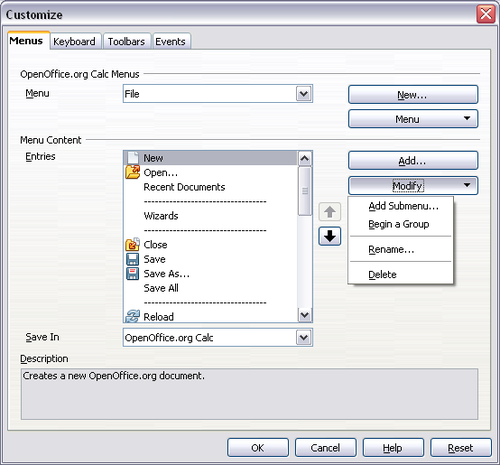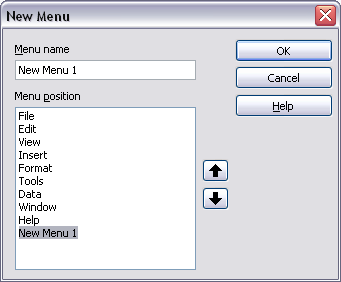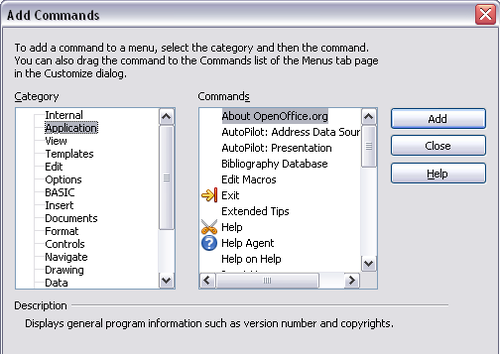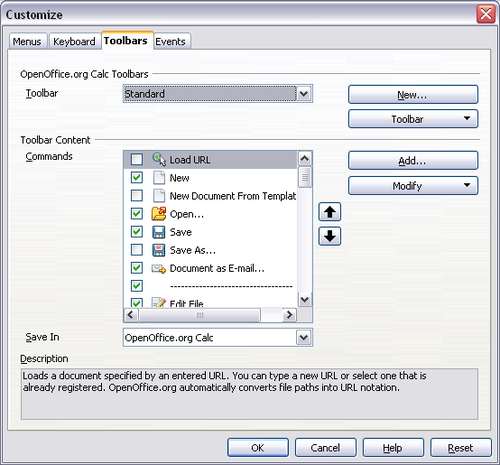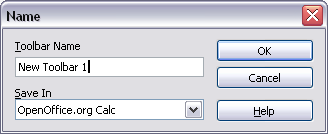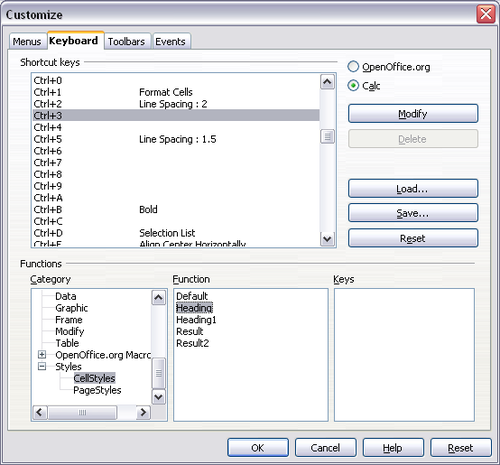Difference between revisions of "Documentation/OOo3 User Guides/Calc Guide/Customizing the user interface"
(New page: {{DISPLAYTITLE:Customizing the user interface}} {{Documentation/CG3AppDTOC |ShowPrevNext=block |PrevPage=Documentation/OOo3_User_Guides/Calc Guide/Calc options |NextPage=Documentation/OOo3...) |
|||
| Line 132: | Line 132: | ||
# On the ''Keyboard'' page of the Customize dialog, | # On the ''Keyboard'' page of the Customize dialog, | ||
| − | [[Image: | + | [[Image:CG3AppDF16.png|thumb|none|500px|''Assigning a cell style to a key combination'']] |
# Choose the shortcut keys you want to assign a style to. In this example, we have chosen ''Ctrl+3''. | # Choose the shortcut keys you want to assign a style to. In this example, we have chosen ''Ctrl+3''. | ||
Revision as of 22:45, 3 April 2009
If you want to change the menu font from that supplied by OOo to the system font for your operating system, do this:
- Choose Tools > Options > OpenOffice.org > View.
- Check Use system font for user interface and click OK.
In addition to changing the menu font, you can add and rearrange items on the menu bar, add items to menus, and make other changes.
To customize menus:
- Choose Tools > Customize.
- On the Customize dialog, pick the Menus page.
- In the Save In drop-down list, choose whether to save this changed menu for Calc or for a selected document.
- In the section OpenOffice.org Calc Menus, select from the Menu drop-down list the menu that you want to customize. The list includes all the main menus as well as sub-menus, that is menus that are contained under another menu. For example, in addition to File, Edit, View, and so on, there is File | Send and File |Templates. The commands available for the selected menu are shown in the central part of the dialog.
- To customize the selected menu, click on the Menu or Modify buttons. You can also add commands to a menu by clicking on the Add button. These actions are described in the following sections. Use the up and down arrows next to the Entries list to move the selected menu item to a different position.
- When you have finished making all your changes, click OK to save them.
In the Customize dialog, click New to display the dialog shown below.
- Type a name for your new menu in the Menu name box.
- Use the up and down arrow buttons to move the new menu into the required position on the menu bar.
- Click OK to save.
The new menu now appears on the list of menus in the Customize dialog. (It will appear on the menu bar itself after you save your customizations.)
After creating a new menu, you need to add some commands to it, as described in Adding a command to a menu.
To modify an existing menu, select it in the Menu list and click the Menu button to drop down a list of modifications: Move, Rename, Delete. Not all of these modifications can be applied to all the entries in the Menu list. For example, Rename and Delete are not available for the supplied menus.
To move a menu (such as File), choose Menu > Move. A dialog similar to the one shown above (but without the Menu name box) opens. Use the up and down arrow buttons to move the menu into the required position.
To move submenus (such as File | Send), select the main menu (File) in the Menu list and then, in the Menu Content section of the dialog, select the submenu (Send) in the Entries list and use the arrow keys to move it up or down in the sequence. Submenus are easily identified in the Entries list by a small black triangle on the right hand side of the name.
In addition to renaming, you can specify a keyboard shortcut that allows you to select a menu command when you press Alt+ an underlined letter in a menu command.
- Select a menu or menu entry.
- Click the Menu button and select Rename.
- Add a tilde (~) in front of the letter that you want to use as an accelerator. For example, to select the Save All command by pressing Alt+V, enter Sa~ve All.
You can add commands to the supplied menus and to menus you have created. On the Customize dialog, select the menu in the Menu list and click the Add button in the Menu Content section of the dialog.
On the Add Commands dialog, select a category and then the command, and click Add. The dialog remains open, so you can select several commands. When you have finished adding commands, click Close. Back on the Customize dialog, you can use the up and down arrow buttons to arrange the commands in your preferred sequence.
In addition to changing the sequence of entries on a menu or submenu, you can add submenus, rename or delete the entries, and add group separators.
To begin, select the menu or submenu in the Menu list near the top of the Customize page, then select the entry in the Entries list under Menu Content. Click the Modify button and choose the required action from the drop-down list of actions.
Most of the actions should be self-explanatory. Begin a group adds a separator line after the highlighted entry.
Customizing toolbars
You can customize toolbars in several ways, including choosing which icons are visible and locking the position of a docked toolbar, as described in Chapter 1 (Introducing OpenOffice.org) of the Getting Started guide. This section describes how to create new toolbars and add other icons (commands) to the list of those available on a toolbar.
To get to the toolbar customization dialog, do any of the following:
- On the toolbar, click the arrow at the end of the toolbar and choose Customize Toolbar.
- Choose View > Toolbars > Customize from the menu bar.
- Choose Tools > Customize from the menu bar and pick the Toolbars page (Figure 14).
To customize toolbars:
- In the Save In drop-down list, choose whether to save this changed toolbar for Calc or for a selected document.
- In the section OpenOffice.org Calc Toolbars, select from the Toolbar drop-down list the toolbar that you want to customize.
- You can create a new toolbar by clicking on the New button, or customize existing toolbars by clicking on the Toolbar or Modify buttons, and add commands to a toolbar by clicking on the Add button. These actions are described below.
- When you have finished making all your changes, click OK to save them.
Creating a new toolbar
To create a new toolbar:
- Choose Tools > Customize > Toolbars from the menu bar.
- Click New. On the Name dialog, type the new toolbar's name and choose from the Save In drop-down list where to save this changed menu: for Calc or for a selected document.
The new toolbar now appears on the list of toolbars in the Customize dialog. After creating a new toolbar, you need to add some commands to it, as described below.
Adding a command to a toolbar
If the list of available buttons for a toolbar does not include all the commands you want on that toolbar, you can add commands. When you create a new toolbar, you need to add commands to it.
- On the Toolbars page of the Customize dialog, select the toolbar in the Toolbar list and click the Add button in the Toolbar Content section of the dialog.
- The Add Commands dialog is the same as for adding commands to menus. Select a category and then the command, and click Add. The dialog remains open, so you can select several commands. When you have finished adding commands, click Close. If you insert an item which does not have an associated icon, the toolbar will display the full name of the item: the next section describes how to choose an icon for a toolbar command.
- Back on the Customize dialog, you can use the up and down arrow buttons to arrange the commands in your preferred sequence.
- When you are done making changes, click OK to save.
Choosing icons for toolbar commands
Toolbar buttons usually have icons, not words, on them, but not all of the commands have associated icons.
To choose an icon for a command, select the command and click Modify > Change icon. On the Change Icon dialog, scroll through the available icons, select one, and click OK to assign it to the command.
To use a custom icon, create it in a graphics program and import it into OOo by clicking the Import button on the Change Icon dialog. Custom icons must be 16 x 16 or 26 x 26 pixels in size and cannot contain more than 256 colors.
Customizing keyboard shortcuts
In addition to using the built-in keyboard shortcuts (listed in Appendix A), you can define your own. You can assign shortcuts to standard OOo functions or your own macros and save them for use with the entire OpenOffice.org suite or only for Calc.
To adapt shortcut keys to your needs, use the Customize dialog, as described below.
- Select Tools > Customize > Keyboard. The Keyboard page of the Customize dialog opens.
- To have the shortcut key assignment available only with Calc, select Calc in the upper right corner of the page; otherwise select OpenOffice.org to make it available to every component.
- Next select the required function from the Category and Function lists.
- Now select the desired shortcut keys in the Shortcut keys list and click the Modify button at the upper right.
- Click OK to accept the change. Now the chosen shortcut keys will execute the function chosen in step 3 above whenever they are pressed.
Example: Assigning styles to shortcut keys
You can configure shortcut keys to quickly assign styles in your document.
- On the Keyboard page of the Customize dialog,
- Choose the shortcut keys you want to assign a style to. In this example, we have chosen Ctrl+3.
- In the Functions section at the bottom of the dialog, scroll down in the Category list to Styles. Click the + sign to expand the list of styles.
- Choose the category of style. (This example uses a cell style, but you can also choose page styles.) The Function list now displays the names of the available styles for the selected category. The example shows OOo’s predefined cell styles.
- To assign Ctrl+3 to be the shortcut key combination for the Heading style, select Heading in the Function list, and then click Modify. Ctrl+3 now appears in the Keys list on the right, and Heading appears next to Ctrl+3 in the Shortcut keys box at the top.
- Make any other required changes, and then click OK to save these settings and close the dialog.
Saving changes to a file
Changes to the shortcut key assignments can be saved in a keyboard configuration file for use at a later time, thus permitting you to create and apply different configurations as the need arises. To save keyboard shortcuts to a file:
- After making your keyboard shortcut assignments, click the Save button near the bottom right of the Customize dialog.
- In the Save Keyboard Configuration dialog, select All files from the Save as Type list.
- Next enter a name for the keyboard configuration file in the File name box, or select an existing file from the list. If you need to, browse to find a file from another location.
- Click Save. A confirmation dialog appears if you are about to overwrite an existing file, otherwise there will be no feedback and the file will be saved.
Loading a saved keyboard configuration
To load a saved keyboard configuration file and replace your existing configuration, click the Load button near the bottom right of the Customize dialog, and then select the configuration file from the Load Keyboard Configuration dialog.
Resetting the shortcut keys
To reset all of the keyboard shortcuts to their default values, click the Reset button near the bottom right of the Customize dialog. Use this feature with care as no confirmation dialog will be displayed; the defaults will be set without any further notice or user input.
Running macros from key combinations
You can also define shortcut key combinations that will run macros. These shortcut keys are strictly user-defined; none are built in. For information on macros, see Chapter 13 (Getting Started with Macros) in the Getting Started guide.
| Content on this page is licensed under the Creative Common Attribution 3.0 license (CC-BY). |
